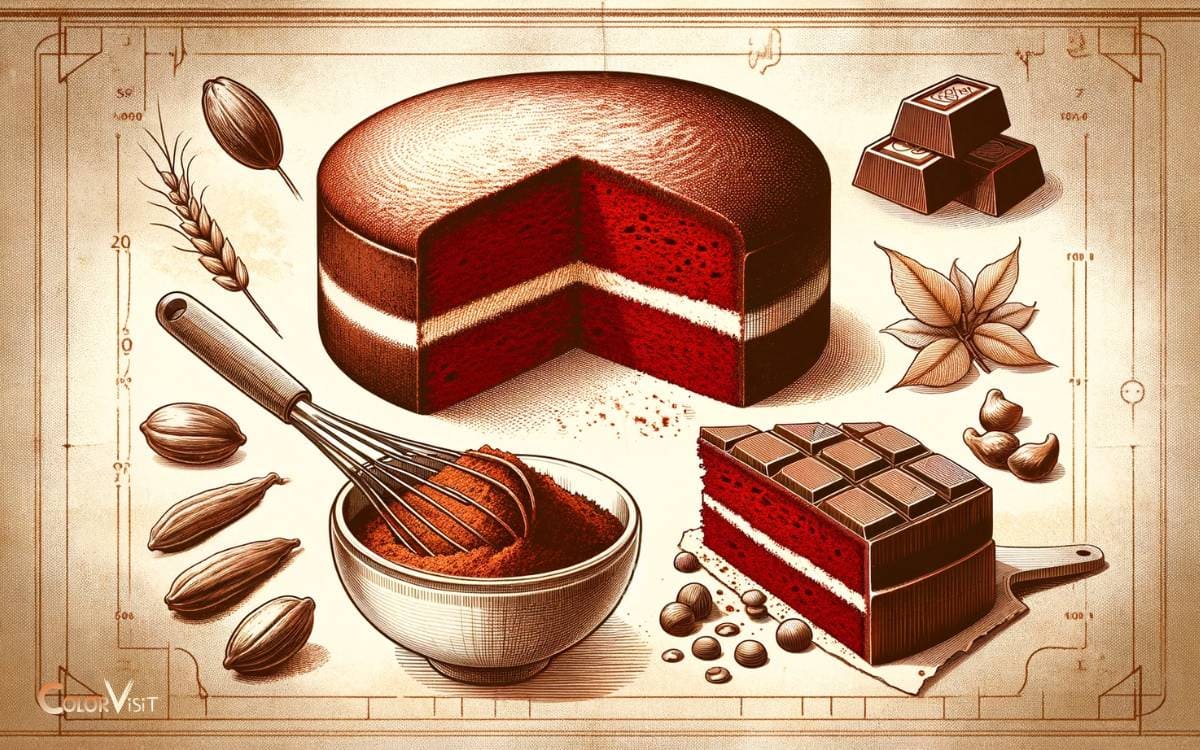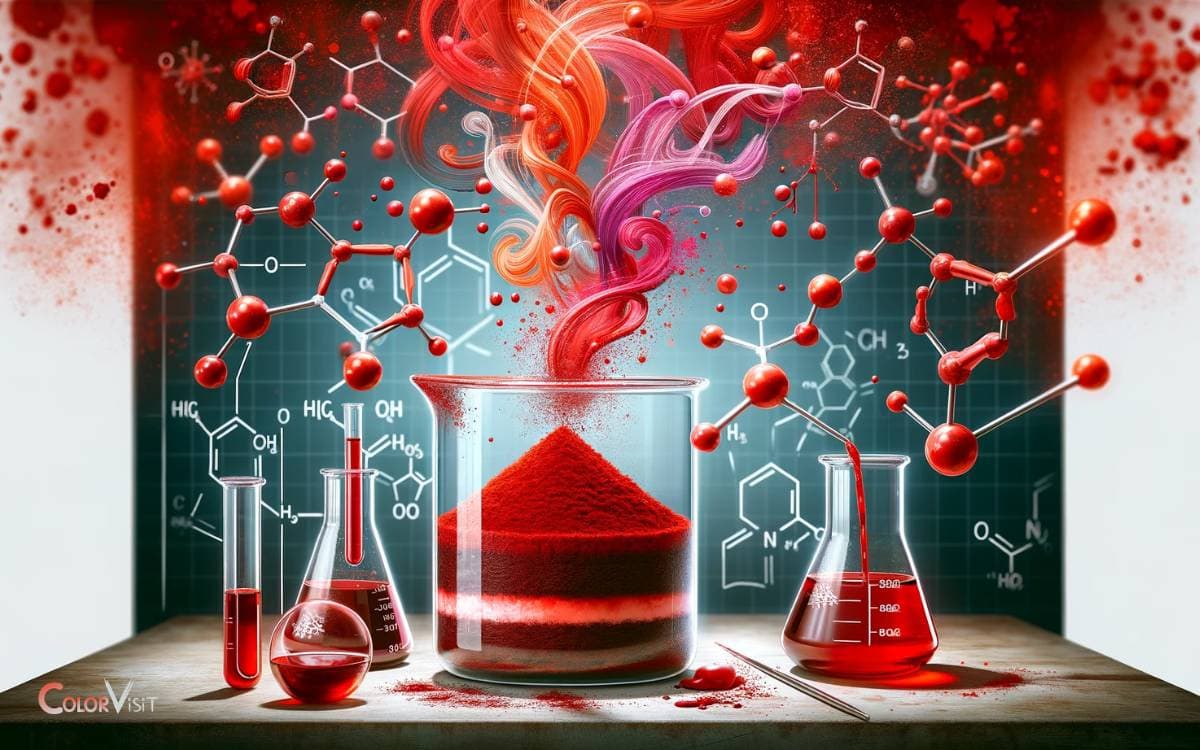How Does Red Velvet Get Its Color? Vibrant!
Red velvet cake primarily gets its vibrant color from the food coloring that is added to the cake batter.
However, traditionally, the reaction between cocoa powder, which contains anthocyanins, and acidic vinegar and buttermilk is responsible for its reddish-brown color.
The red color of the red velvet cake comes from the addition of red food coloring to the batter.
However, in the past, before food coloring was widely used, the red color was achieved by a chemical reaction.
Cocoa powder, an ingredient in the cake, contains anthocyanins, a type of flavonoid that can change color depending on the pH level of the substance it’s mixed with.
When mixed with acidic ingredients like vinegar and buttermilk, a natural reaction occurs that gives the cake a reddish-brown hue.
For instance, if you were to bake a red velvet cake using only cocoa powder, vinegar, and buttermilk without any food coloring, the cake would have a more subtle, reddish-brown color.
However, the traditional chemical reaction between cocoa and acidic ingredients remains a fascinating part of culinary history, as a testament to the innovative ways in which chefs can use science in their recipes.
Key Takeaway
The Origins of Red Velvet
Red velvet’s origins can be traced back to the 19th century, when the distinctive red color was achieved through the reaction of acidic buttermilk and cocoa with natural alkaline agents.
- This iconic cake has a rich history, with its roots in the United States. Originally, the red color was intensified by the chemical reaction between the acidic ingredients and cocoa powder.
- Over time, recipes have evolved, and the vibrant hue is now often achieved through food coloring, but the traditional method of using natural ingredients still exists.
- Red velvet has undergone a fascinating journey from its humble beginnings to becoming a beloved flavor and symbol of indulgence.
Its intriguing history continues to captivate bakers and food enthusiasts, driving the ongoing innovation and creativity in the realm of culinary arts.
The Role of Cocoa in Red Velvet
The role of cocoa in red velvet cake is critical to achieving its distinct flavor and contributing to the chemical reaction that results in its characteristic color.
Cocoa’s influence goes beyond taste, as it interacts with acidic ingredients to reveal the cake’s signature red hue.
The anthocyanin compounds present in cocoa undergo a reaction in the presence of acid and buttermilk, leading to the development of the cake’s vibrant red color.
The table below outlines the chemical reaction and the resulting color development in red velvet cake:
| Chemical Reaction | Color Development |
|---|---|
| Acid + Cocoa | Red hue |
| Buttermilk + Cocoa | Vibrant color |
| Anthocyanin + Acid | Signature red |
Understanding the pivotal role of cocoa and its chemical interactions provides insight into the unique qualities of red velvet cake, appealing to those with a penchant for culinary innovation.
Unveiling the Secret Ingredient
An essential element in achieving the distinctive color of red velvet cake is the addition of a specific secret ingredient.
- This secret ingredient is none other than vinegar. While it may seem surprising, vinegar plays a crucial role in the color chemistry of red velvet.
- The acidic nature of vinegar not only reacts with the cocoa powder to enhance its reddish color but also helps to maintain the cake’s texture.
- Furthermore, the acidity of vinegar intensifies the red hue by interacting with the anthocyanin present in the cocoa powder.
- This unique chemical reaction contributes to the vibrant red shade characteristic of red velvet.
- As we delve deeper into the color chemistry behind red velvet, it becomes evident that the addition of vinegar is a key factor in achieving the cake’s iconic color.
Chemical Reaction: The Red Transformation
The addition of vinegar induces a significant chemical transformation, intensifying the red hue and contributing to the vibrant shade characteristic of red velvet.
- This chemical reaction plays a pivotal role in the color development of red velvet, captivating the senses and sparking intrigue.
- The process involves a series of intricate molecular interactions that culminate in the striking red transformation, enhancing the visual allure of the dessert.
- The marriage of science and culinary artistry results in a visually stunning and alluring treat that captivates both the eyes and the taste buds.
- This innovative approach to color development elevates the red velvet experience, evoking a sense of wonder and anticipation.
Red Velvet’s Color Evolution
Red Velvet’s color evolution reflects the culmination of intricate chemical processes and culinary ingenuity, resulting in its iconic vibrant hue. The depth of this color is achieved through a careful balance of ingredients, including cocoa powder and buttermilk, which interact to produce the signature shade. For those seeking to replicate this rich color in a different medium, knowing how to create red velvet paint can be a delightful endeavor, blending red pigments with hints of white and black to mimic the cake’s characteristic tone. This unique combination not only enhances the visual appeal but also pays homage to the dessert’s beloved aesthetic.
The color symbolism of red velvet has historical significance, with its evolution mirroring shifts in cultural and culinary trends.
The following table highlights key milestones in the color evolution of red velvet, showcasing how it has transformed over time:
| Time Period | Color Evolution | Culinary Innovation |
|---|---|---|
| 1800s | Natural red color from cocoa powder | Traditional recipes |
| Mid-1900s | Introduction of artificial food coloring | Modernization of recipes |
| Present day | Embracing natural food dyes | Fusion of traditional and modern techniques |
This evolution not only signifies the adaptation of red velvet to changing culinary practices but also represents the enduring allure of its rich, red hue throughout history.
Conclusion
The rich and vibrant color of red velvet is a result of a complex chemical reaction between acidic and alkaline ingredients.
Like a carefully choreographed dance, the combination of cocoa, buttermilk, and vinegar creates a stunning visual transformation, turning the batter into a deep crimson hue.
This unique process has captivated bakers and dessert enthusiasts for generations, making red velvet a timeless and beloved treat.






